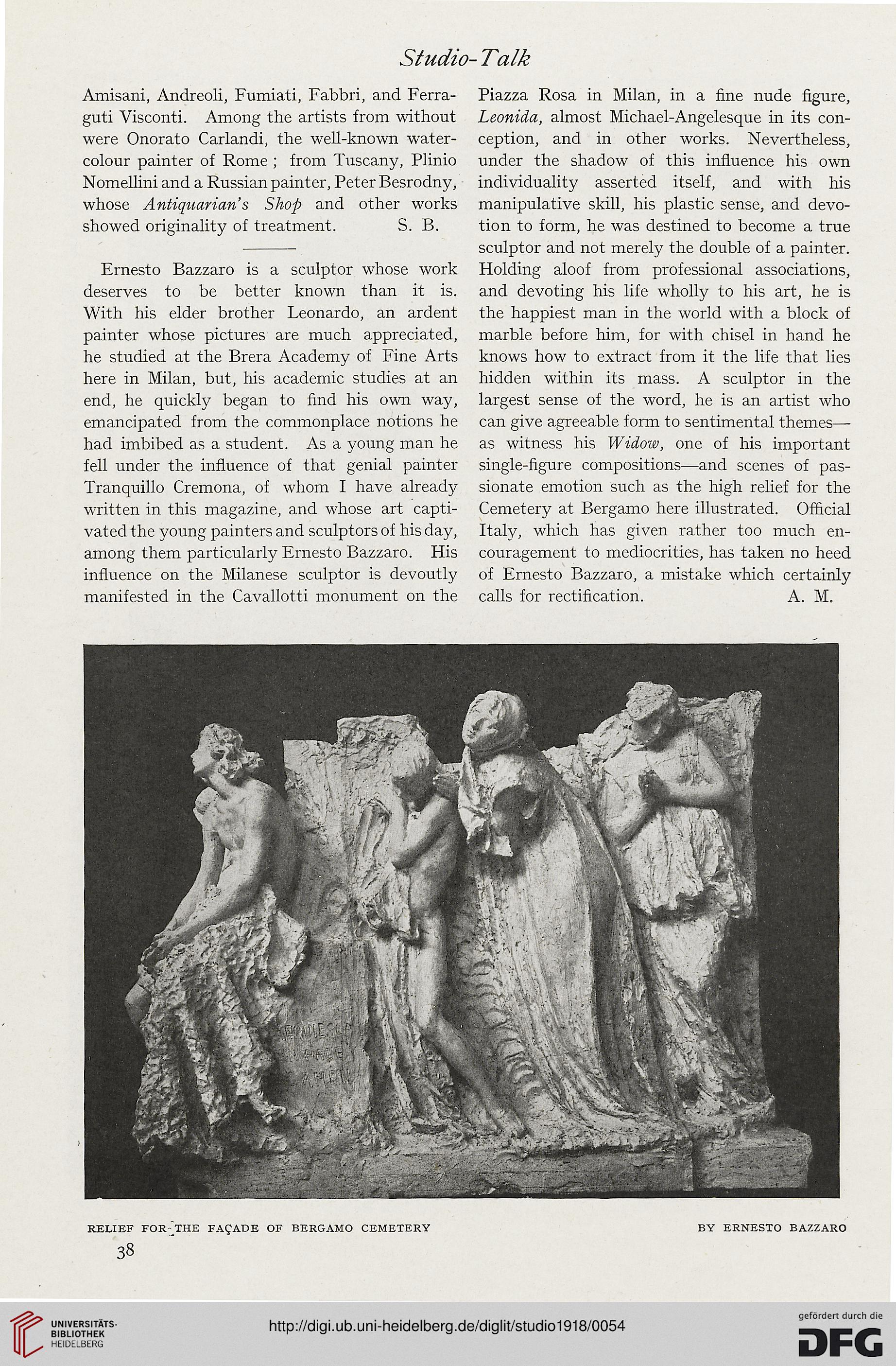Studio-Talk
Amisani, Andreoli, Fumiati, Fabbri, and Ferra-
guti Visconti. Among the artists from without
were Onorato Carlandi, the well-known water-
colour painter of Rome ; from Tuscany, Plinio
Nomellini and a Russian painter, Peter Besrodny,
whose Antiquarian’s Shop and other works
showed originality of treatment. S. B.
Ernesto Bazzaro is a sculptor whose work
deserves to be better known than it is.
With his elder brother Leonardo, an ardent
painter whose pictures are much appreciated,
he studied at the Brera Academy of Fine Arts
here in Milan, but, his academic studies at an
end, he quickly began to find his own way,
emancipated from the commonplace notions he
had imbibed as a student. As a young man he
fell under the influence of that genial painter
Tranquillo Cremona, of whom I have alread)?
written in this magazine, and whose art capti-
vated the young painters and sculptors of his day,
among them particularly Ernesto Bazzaro. His
influence on the Milanese sculptor is devoutly
manifested in the Cavallotti monument on the
Piazza Rosa in Milan, in a fine nude figure,
Leonida, almost Michael-Angelesque in its con-
ception, and in other works. Nevertheless,
under the shadow of this influence his own
individuality asserted itself, and with his
manipulative skill, his plastic sense, and devo-
tion to form, he was destined to become a true
sculptor and not merely the double of a painter.
Holding aloof from professional associations,
and devoting his life wholly to his art, he is
the happiest man in the world with a block of
marble before him, for with chisel in hand he
knows how to extract from it the life that lies
hidden within its mass. A sculptor in the
largest sense of the word, he is an artist who
can give agreeable form to sentimental themes—-
as witness his Widow, one of his important
single-figure compositions—and scenes of pas-
sionate emotion such as the high relief for the
Cemetery at Bergamo here illustrated. Official
Italy, which has given rather too much en-
couragement to mediocrities, has taken no heed
of Ernesto Bazzaro, a mistake which certainly
calls for rectification. A. M.
Amisani, Andreoli, Fumiati, Fabbri, and Ferra-
guti Visconti. Among the artists from without
were Onorato Carlandi, the well-known water-
colour painter of Rome ; from Tuscany, Plinio
Nomellini and a Russian painter, Peter Besrodny,
whose Antiquarian’s Shop and other works
showed originality of treatment. S. B.
Ernesto Bazzaro is a sculptor whose work
deserves to be better known than it is.
With his elder brother Leonardo, an ardent
painter whose pictures are much appreciated,
he studied at the Brera Academy of Fine Arts
here in Milan, but, his academic studies at an
end, he quickly began to find his own way,
emancipated from the commonplace notions he
had imbibed as a student. As a young man he
fell under the influence of that genial painter
Tranquillo Cremona, of whom I have alread)?
written in this magazine, and whose art capti-
vated the young painters and sculptors of his day,
among them particularly Ernesto Bazzaro. His
influence on the Milanese sculptor is devoutly
manifested in the Cavallotti monument on the
Piazza Rosa in Milan, in a fine nude figure,
Leonida, almost Michael-Angelesque in its con-
ception, and in other works. Nevertheless,
under the shadow of this influence his own
individuality asserted itself, and with his
manipulative skill, his plastic sense, and devo-
tion to form, he was destined to become a true
sculptor and not merely the double of a painter.
Holding aloof from professional associations,
and devoting his life wholly to his art, he is
the happiest man in the world with a block of
marble before him, for with chisel in hand he
knows how to extract from it the life that lies
hidden within its mass. A sculptor in the
largest sense of the word, he is an artist who
can give agreeable form to sentimental themes—-
as witness his Widow, one of his important
single-figure compositions—and scenes of pas-
sionate emotion such as the high relief for the
Cemetery at Bergamo here illustrated. Official
Italy, which has given rather too much en-
couragement to mediocrities, has taken no heed
of Ernesto Bazzaro, a mistake which certainly
calls for rectification. A. M.




